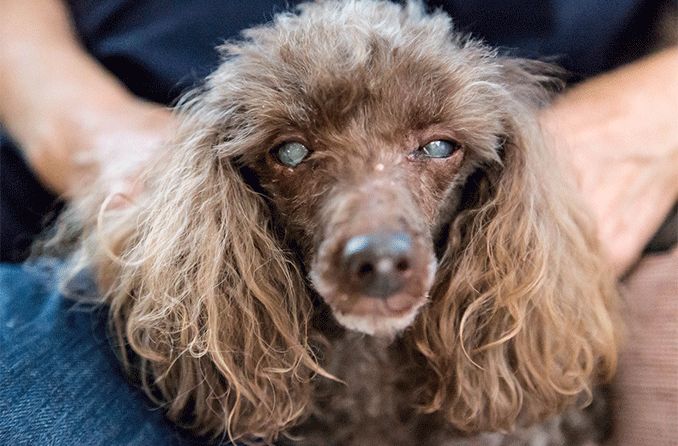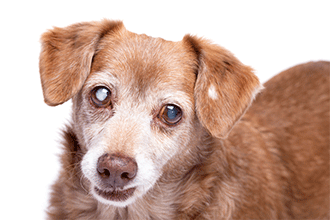Cataracts in dogs

Cataracts in dogs
Dogs, like humans, can develop cataracts that make it difficult to see. It’s important to know the signs of poor vision in your dog and to seek guidance from a veterinarian early, when treatment can still make a difference.
Surgery to remove cataracts can prevent blindness and significantly improve your dog’s vision. But even when surgery is not appropriate, most dogs can learn to adapt to poor vision and continue to live a good and happy life.
Are cataracts in dogs like cataracts in humans?
Cataracts affect both humans and dogs, which is not surprising. The eyes of both have a cornea, pupil, lens and retina, and it is the lens that is vulnerable to cataracts.
Think of the lens of the eye like the lens of a camera. It focuses the light that comes into the eye, producing clear, crisp images on the retina.
The lens is composed of water and special transparent proteins. With age or illness, the proteins start to clump together, causing the lens to become cloudy. Eventually those protein clumps form a cataract that scatters or blocks the light coming through the lens.
Cataracts usually develop in both eyes, but not always at the same speed. This means your dog may be able to see better with one eye, since that cataract may be less advanced than the other.
When cataracts grow large enough to interfere with vision significantly, they are called mature cataracts.
What causes cataracts in dogs?
The most common causes of cataracts in dogs are:
Aging
Eye injuries
Illness or disease
Hereditary cataracts
Scientists have discovered mutations in the HSF4 gene that may cause hereditary cataracts in Staffordshire bull terriers, Boston terriers and Australian shepherds. Hereditary cataracts can also affect many other breeds, including:
Smooth fox terriers
Havanese
American cocker spaniels
Miniature, toy and standard poodles
Silky terriers
Welsh springer spaniels
Siberian huskies
Bichon frisés
Miniature schnauzers
Cataracts in diabetic dogs
Cataracts caused by diabetes mellitus (sugar diabetes) result when high blood sugar levels change the balance of water in the lens. They can grow quickly and often lead to blindness. In fact, around 75% of diabetic dogs will develop cataracts within 6 to 12 months of being diagnosed with diabetes.
How can you tell if your dog has cataracts?

In many cases, cataracts in your four-legged friend can develop slowly. You and your dog may not even notice them at first, but they are fairly easy to pick up once they are more advanced. You may notice the following signs and symptoms:
As the cataract grows and the lens becomes clouded, the pupils of your dog’s eyes may appear bluish, gray or white.
Your pet may seem clumsy, bumping into walls or furniture.
Your dog may no longer want to jump on furniture or may hesitate to use stairways.
Your pet may have trouble finding the food or water bowl.
Your dog may misjudge distances.
Your dog’s eyes may have discharge, and the whites of the eyes may appear red.
It’s important to note that changes in the appearance of your dog’s eyes don’t always signal a cataract. There is a condition called lenticular (or nuclear) sclerosis that is common in older dogs, and it also gives a bluish haze to the lens of the eye.
Similar to cataracts, nuclear sclerosis can make your dog’s pupil appear cloudy or bluish, especially in low light conditions when the pupil is dilated. In nuclear sclerosis, this is a normal change in the lens that occurs with aging, and it shouldn’t make it harder for your dog to see.
Your veterinarian will be able to tell the difference. So, if you notice anything strange or different about your dog’s eyes, make an appointment with your vet to get them checked out.
How to prevent canine cataracts
Unfortunately, there’s not much you can do to prevent cataracts. But you can help preserve your dog’s vision by examining their eyes regularly and making sure they see the veterinarian for regular checkups.
Routine visits to the vet will help ensure that any potential conditions are detected and treated early. This is especially important for diabetes and cataracts, both of which can lead to complications and other conditions, including canine glaucoma or uveitis.
Finally, if your dog belongs to a breed that is or vulnerable to cataracts, you can keep a closer watch on their vision and examine their eyes more frequently. And if you’re looking for a new puppy in one of those cataract-prone breeds, look for a responsible breeder that does genetic testing for hereditary cataracts. This gives you and your new puppy a better chance of avoiding those problematic genes.
Diagnosing cataracts in dogs
If you suspect your dog is suffering from vision problems, and possibly cataracts, schedule an eye exam with your veterinarian. A bright light allows your dog’s doctor to look into the back of the eye to see if there is a cataract. Your vet will be able to tell you if the cataracts are:
Incipient – So small they affect less than 15% of your dog’s lenses and don’t cause any visual impairment (yet).
Immature – More than 15% of the lens is affected, but the retina isn’t yet obscured. Visual impairment is mild.
Mature – The cataract covers the entire lens and obscures the retina. Blindness may have set in.
Hypermature – The lens begins to shrink, and uveitis may occur.
Early detection is important because treatment is more likely to be successful and there is a lower likelihood of complications.
How to treat cataracts in dogs
The best time to treat a cataract is when the eye is still healthy and the cataract is still soft, immature and easily removed. And the best treatment, when suitable for the dog, is cataract surgery.
Cataract surgery for dogs
When appropriate, cataract surgery can go far in restoring a dog’s vision. The procedure most commonly used for dogs is the same as it is for humans: a technique called phacoemulsification, where a special ultrasonic surgical instrument breaks the lens into tiny pieces that can be gently suctioned from the lens capsule.
Cataract surgery is done under general anesthesia by a veterinary ophthalmologist (a veterinarian who specializes in treating animals’ eyes). A lens implant can often be placed during surgery, restoring your dog’s vision to nearly normal.
But even if your dog isn’t a good candidate for a lens implant, his vision will still be significantly improved (with the potential exception of a little trouble focusing on near objects).
After cataract surgery
The doctor will instruct you on giving your dog post-operative pain medications and eye drops to help with recovery. Your dog will also need to wear a hard-sided collar (or recovery cone) for two weeks to protect their eyes from scratching and rubbing.
Most dogs will return to normal activity, eating, playing, running and jumping only a few days after surgery.
Managing canine cataracts
Cataract surgery isn’t an option for everyone. Sometimes:
Surgery is too risky due to a dog’s eye inflammation (uveitis), other health issues and/or a dog’s inability to undergo general anesthesia.
No veterinary ophthalmologists offer cataract surgery nearby.
Surgery is too expensive.
If this is the case for you, ask your vet how you can maintain your dog’s comfort and control their eye inflammation as the cataracts progress. This can usually be done with anti-inflammatory eye drops and eye lubricants.
As the cataracts progress and inflammation worsens, your dog may eventually develop glaucoma, which is a painful and sight-threatening condition that results when pressure inside the eye is too high. If this happens, eye drops are often prescribed to help control the pressure.
In rare cases of severe and untreatable cataracts, a dog can lose its sight. Even so, dogs are loving, playful, happy creatures, and with a little extra guidance and help from you, your pet can still live a long and happy life.
Is your senior dog starting to lose her sight? Learn how to keep her days stress-free with our guide to caring for a blind or vision-impaired dog.
READ NEXT: Cataracts in cats
Cataracts in dogs. VCA Animal Hospital. Accessed April 2021.
Identification of mutations in HSF4 in dogs of three different breeds with hereditary cataracts. Veterinary Ophthalmology. Sep-Oct 2006.
The genetics of eye disorders in the dog. Canine Genetics and Epidemiology. April 2014.
Prevalence of primary breed-related cataracts in the dog in North America. Veterinary Ophthalmology. Mar-Apr 2005.
Cataracts in diabetic dogs. Veterinary Partner. August 2019.
A retrospective-cohort study on the development of cataracts in dogs with diabetes mellitus: 200 cases. Veterinary Ophthalmology. 1999.
Cataracts in dogs: The importance of early detection and management. Today’s Veterinary Nurse. Summer 2020.
Cataracts in dogs. Great Pet Care. Accessed April 2021.
Page published on Wednesday, April 21, 2021






